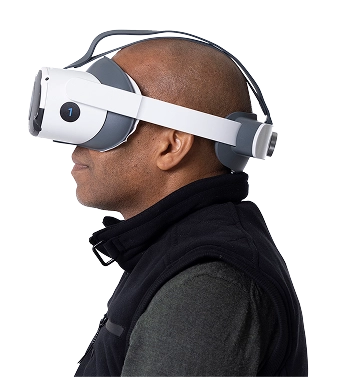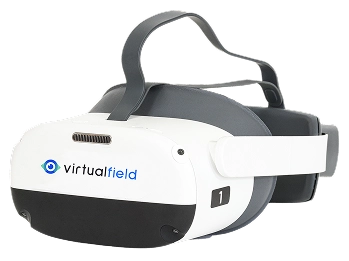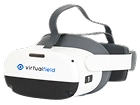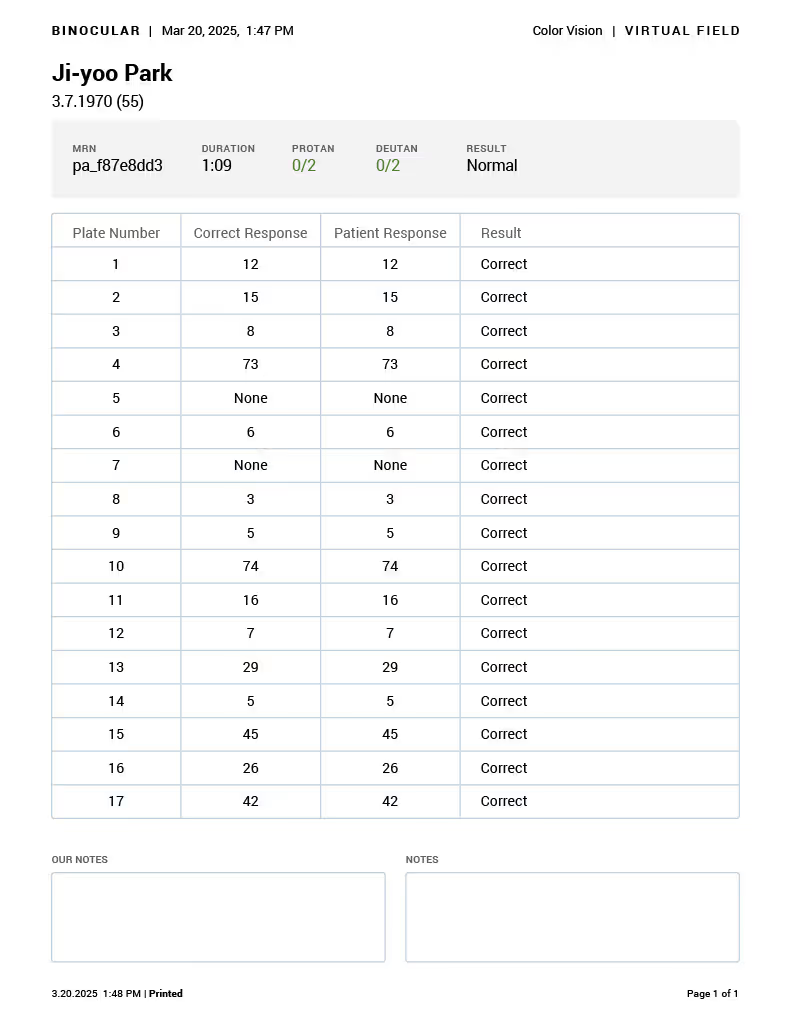Patients can go their entire lives without noticing color blindness, but you can identify over 90% of cases with a single two-minute test. The Ishihara screening tool remains one of the most widely trusted methods for identifying red-green deficiencies — and with a digital Ishihara color test, you can now eliminate guesswork and lighting inconsistencies entirely.
While curious patients may come across virtual color vision plates online or in apps, these at-home tests don’t match the accuracy of a professional, standardized platform like Virtual Field’s portable color blindness device.
This guide will cover the fundamentals of the Ishihara test from an eye care professional’s perspective and highlight how Virtual Field improves on this hundred-year-old testing process.
Digital Ishihara Color Vision Test Overview
As a diagnostic tool, the Ishihara color vision test is simple: patients are provided a series of images and asked to identify what they see. Each image presents colored dots arranged in a pattern that obscures a number or shape. Depending on the patient’s color vision abilities, the image will either be visible, invisible, or altered.
The Ishihara color vision test is iconic. Patients may not know it by name, but it’s so common and recognizable that there’s a good chance your patients have already seen and completed an Ishihara test on their own. They may even have come to the conclusion that they’re experiencing red-green colorblindness.
Of course, self-diagnosis isn’t reliable — especially when patients experiment with images online or in printed materials. Virtual Field’s virtual color vision plates eliminate the variables of poor lighting, printing errors, screen inconsistencies, or damaged charts — all within a portable color blindness device that makes testing more precise, accessible, and clinically reliable.
Academic references and clinical validation
A longstanding study evaluated the efficiency of the Ishihara test’s transformation and vanishing plates and revealed that it was accurate in 95.5% - 99% of cases. Hidden digit plates required additional testing.
Research shows that the Ishihara test is accessible and effective, even among young children. A population study showed that 96.5% of children ages 3 to 6 could complete this test.
The Ishihara test is versatile. Studies show that it can be effectively administered in multiple formats — traditional printed plates, digital versions on the internet or smartphone apps, and virtual reality.
We built a virtual reality visual field testing solution to ensure accessible and inclusive vision testing experiences for every patient.
.avif)

30 days free.
No strings attached.
We are confident you’ll love Virtual Field just like the 2,000 doctors who have already made the switch.
The Ishihara Color Vision Test at a Glance
The Ishihara test is so straightforward that patients can, and often do, use it to self-diagnose color blindness. Of course, their methodology is probably not accurate, so you’ll need to confirm with your own exam. Patients tend to appreciate this test’s simplicity and familiarity, but optometrists may feel constrained by its limitations. It can only identify red-green color vision deficiencies, and it can’t provide insight into visual acuity, so positive Ishihara test results will require additional testing.
With a digital Ishihara screening tool, you can deliver consistent results no matter where testing takes place, which is ideal for mobile eye clinics, pediatric vision screenings, or high-volume practices.
Pros and cons of the Ishihara Test
The pros and cons that follow can help guide you toward the ideal scenarios to incorporate this test into your patients' diagnostic assessments.
Pros
Ishihara testing is simple and widely recognized as an efficient way to detect red-green color blindness.
Patients find the Ishihara test quick and non-invasive. Those with normal color vision may even consider it fun.
For children and people who cannot read numbers, you can administer the Ishihara test using shapes or traceable patterns.
With Virtual Field’s virtual color vision plates, the Ishihara test is reliable, fast, and conclusive.
Now available via a portable color blindness device — no plates to manage or lighting adjustments needed.
Cons
Ishihara color vision testing is limited and cannot diagnose the cause of color perception.
For patients with color vision deficiencies, immediate pass/fail results can be an emotional or shocking experience.
Ishihara testing focuses on red-green deficiency and doesn’t assess blue-yellow deficiency (tritanopia) or total color blindness.
When using traditional plates instead of Virtual Field, factors like poor lighting, damaged plates, or testing confusion can lead to inaccurate results.
This test is not individually billable.
List of Ocular Diseases Monitored and Diagnoses Identified by the Ishihara Color Vision Test
Protanopia and deuteranopia
About 8% of men and 0.5% of women have congenital color vision deficiencies. The Ishihara test is specifically designed to reveal protanopia (red blindness) and deuteranopia (green blindness).
Macular Degeneration
The macula is responsible for central vision and color perception, so over time, age-related macular degeneration can impair a patient’s ability to distinguish colors. The Ishihara test is most useful in the later stages of AMD.
8%
About 8% of men have congenital color vision deficiencies.
0.5%
About 0.5% of women have congenital color vision deficiencies.
Acquired color vision deficiencies
Hydroxychloroquine and other drugs that can impact vision can lead to color vision deficiencies. Patients who experience chemical exposure or radiation may also benefit from the Ishihara test, especially if exposure is ongoing.
Optic Neuropathies
Red-green color vision deficiencies are commonly associated with optic nerve damage. The Ishihara test can be an early indicator of optic nerve dysfunction and trigger further evaluation.
Other Conditions
The Ishihara color vision test can also be used to monitor or diagnose:
- Metabolic disorders like vitamin A deficiency or Wilson’s disease
- Cataracts, retinal detachment, or diabetic retinopathy
- Neurological and optic nerve disorders
For clinicians looking to buy digital Ishihara solutions, digital platforms like Virtual Field offer a reliable upgrade over worn booklets or outdated materials.
Example Ishihara Color Vision Test Report
30 days free.
No strings attached.
We are confident you’ll love Virtual Field just like the 2,000 doctors who have already made the switch.

Color Vision Testing Device Cost: Traditional vs. Virtual Reality Solutions
When evaluating color vision testing device cost options, many eye care professionals consider traditional Ishihara color plates alongside the benefits of an advanced digital solution that offers comprehensive vision and visual field testing.
While printed Ishihara test booklets are relatively inexpensive upfront, costing only a few hundred dollars, they can degrade over time and require ideal lighting conditions for accurate results.
In contrast, a virtual reality-based solution like Virtual Field delivers consistent, high-quality testing environments and eliminates variables such as screen color calibration or physical wear. The subscription includes not only the Ishihara test but a full suite of visual assessments and virtual field exams in a single device. Best of all, the Virtual Field device is available through a cost-effective monthly subscription model, making it accessible for practices of all sizes.
Billing and Coding for the Ishihara Test
The Ishihara color vision test isn’t billable on its own. It does not qualify for the extended color vision examination (CPT code 92283) and isn’t reimbursed.
However, the Ishihara test is often part of a routine, comprehensive eye exam. For new or existing patients, this would be categorized under CPT codes 92004 or 92014, respectively.
When is the Ishihara color vision test required?
The Ishihara color vision test was originally developed in 1918 for the military, and it’s still useful today. The United States military currently administers the Ishihara test as part of its color vision testing standards for military special duty occupations.
This color accuracy test may be required for specific occupations, like pilots and air traffic controllers, police, electricians, engineers, certain healthcare professionals, and even artists. Many optometrists consider it a standard part of routine exams, and it’s often administered to children to ensure accommodations at school.
For many healthy patients, one color vision test is sufficient. But for people with certain professions or those who experience changes in their visual acuity, it may be repeated. Patients with diabetes, glaucoma, macular degeneration, neurological conditions, or eye injuries could need additional testing. People who are exposed to heavy metals, chemicals, or medications that impact vision may be at risk of acquired color vision deficiency.
Is the Ishihara test required for driver’s licenses?
In most states, regular driver’s licenses do not require an Ishihara color vision test, despite the need to distinguish red and green colored stoplights. Massachusetts and Hawaii do require all drivers to distinguish traffic colors, but other states only have color vision requirements for commercial drivers. Most U.S. states prioritize visual acuity, field of vision, and the ability to identify the order of signal lights, not necessarily the colors themselves.
Modernize Your Ishihara Screening Tool with
Virtual Field
Eye care professionals around the world have trusted the Ishihara test for over a century. Virtual Field gets the brightness just right — every time. With virtual color vision plates, there’s never a smudge, misprint, or missing plate. You’ll deliver repeatable, accurate results using a portable color blindness device built for today’s practices. Lighting conditions, screen variations, and wear and tear will eventually lead to less accurate results.
Modernize this time-tested tool for more accurate and conclusive test results that fit seamlessly into your workflow. Save your patients’ Ishihara test results in your EHR, and if your patient needs additional testing, you can quickly move on to more advanced assessments like the Farnsworth D-15. Virtual Field brings the Ishihara test into the digital age — and now it’s even more reliable and accessible.
Want all 23 exam guides in one place?
Download our comprehensive guide for 160+ pages of insights.
FAQs
1. How many errors on a digital Ishihara constitute failure?
2. What CPT code is used for the Ishihara Color Vision Test?
3. Can Ishihara detect blue-yellow defects?
4. How long is the test time for a 38-plate Ishihara Color Vision Test?
5. Are results suitable for FAA or Coast Guard requirements?
Ready to get started?
Schedule a demo or begin your 30-day free trial of Virtual Field to try our EOM exam in your practice.

Questions? Contact sales@virtualfield.io talk to a Virtual Field expert today.



